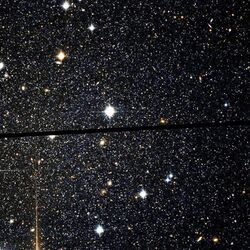Astronomy:Andromeda II
| Andromeda II | |
|---|---|
 Andromeda II, as taken by the Hubble Space Telescope | |
| Observation data (J2000 epoch) | |
| Constellation | Pisces |
| Right ascension | 01h 16m 29.8s[1] |
| Declination | +33° 25′ 09″[1] |
| Redshift | −188 ± 3 km/s[1] |
| Distance | 2.22 ± 0.07 Mly (680 ± 20 kpc)[2][3] |
| Apparent magnitude (V) | 13.5[1] |
| Characteristics | |
| Type | dSph[1] |
| Apparent size (V) | 3.6′ × 2.52′[1] |
| Notable features | satellite galaxy of M31 |
| Other designations | |
| Andromeda II Dwarf Spheroidal,[1] PGC 4601,[1][4] And II[5] | |
Andromeda II (And II) is a dwarf spheroidal galaxy about 2.22 Mly away in the constellation Pisces. While part of the Local Group, it is not quite clear if it is a satellite of the Andromeda Galaxy or the Triangulum Galaxy.[citation needed]
It was discovered by Sidney Van den Bergh[6] in a survey of photographic plates taken with the Palomar 48-inch (1.2 m) Schmidt telescope in 1970 and 1971, together with Andromeda I, Andromeda III, and the presumable non- or background galaxy Andromeda IV.[7]
Nomenclature
Andromeda II has also been given the alias Pisces II by Martin et al. (2009), who also proposed aliases for several other satellite galaxies of the Andromeda Galaxy[8] However, that name was later used by a different group unaware of these names, for a separate galaxy.[9]
Spectra observations
Using the Keck telescope, Côté et al. 1999 observed spectra for seven stars inside Andromeda II. From this data, they found an average velocity Vr of −188 ± 3 km/s and velocity dispersion of 9.2 ± 2.6 km/s. This gives a mass to light ratio of M/Lv of 21+14−10 solar units which implies that And II contains a significant amount of dark matter. Also in 1999, Côté, Oke, & Cohen used the Keck to measure the spectra of 42 red giants. From this, they deduced an average metallicity of <[Fe/H]> = −1.47 ± 0.19 and a dispersion of 0.35 ± 0.10 dex.[5]
In 1999, Da Costa et al. studied the color-magnitude diagram of And II and discovered that most of stars in And II have ages between 6 and 9 Gyr. However, the observation of RR Lyrae variables and blue horizontal-branch stars demonstrates the existence of a population segment with an age greater than 10 Gyr. And II differs from And I in that it does not show a radial gradient in horizontal-branch morphology. Additionally, the dispersion in abundance is significantly larger in And II as compared to And I. This implies that these two dwarf spheroidal companions to the Andromeda galaxy have very different evolutionary histories. This raises the question of whether there is a correlation between a radial horizontal-branch gradient and the metallicity dispersion between dwarf spheroidal galaxies.[5]
History
And II appears to be in the possession of a stellar stream, a feature that is indicative of a merger event in the past.[10] The characteristics of And II can best be explained by the merger of two disky dwarf galaxies, some 5 billion years ago.[11]
See also
References
- ↑ 1.0 1.1 1.2 1.3 1.4 1.5 1.6 1.7 "NASA/IPAC Extragalactic Database". Results for Andromeda II. http://nedwww.ipac.caltech.edu/.
- ↑ I. D. Karachentsev; V. E. Karachentseva; W. K. Hutchmeier; D. I. Makarov (2004). "A Catalog of Neighboring Galaxies". Astronomical Journal 127 (4): 2031–2068. doi:10.1086/382905. Bibcode: 2004AJ....127.2031K.
- ↑ Karachentsev, I. D.; Kashibadze, O. G. (2006). "Masses of the local group and of the M81 group estimated from distortions in the local velocity field". Astrophysics 49 (1): 3–18. doi:10.1007/s10511-006-0002-6. Bibcode: 2006Ap.....49....3K.
- ↑ "NAME Andromeda II". SIMBAD. Centre de données astronomiques de Strasbourg. http://simbad.u-strasbg.fr/simbad/sim-basic?Ident=NAME+Andromeda+II.
- ↑ 5.0 5.1 5.2 Van den Bergh, Sidney (April 2000). "Updated Information on the Local Group". The Publications of the Astronomical Society of the Pacific 112 (770): 533. doi:10.1086/316548. Bibcode: 2000PASP..112..529V.
- ↑ McConnachie, A. W.; Irwin, M. J.; Ferguson, A. M. N.; Ibata, R. A.; Lewis, G. F.; Tanvir, N. (2005). "Distances and metallicities for 17 Local Group galaxies". Monthly Notices of the Royal Astronomical Society 356 (4): 979–997. doi:10.1111/j.1365-2966.2004.08514.x. Bibcode: 2005MNRAS.356..979M.
- ↑ Van den Bergh, Sydney (January 1972). "Search for Faint Companions to M31". Astrophysical Journal 171: L31. doi:10.1086/180861. Bibcode: 1972ApJ...171L..31V.
- ↑ Martin, Nicolas F.; McConnachie, Alan W.; Irwin, Mike; Widrow, Lawrence M.; Ferguson, Annette M. N.; Ibata, Rodrigo A.; Dubinski, John; Babul, Arif et al. (1 November 2009). "PAndAS' CUBS: Discovery of Two New Dwarf Galaxies in the Surroundings of the Andromeda and Triangulum Galaxies". The Astrophysical Journal 705 (1): 758–765. doi:10.1088/0004-637X/705/1/758. Bibcode: 2009ApJ...705..758M.
- ↑ Belokurov, V.; Walker, M. G.; Evans, N. W.; Gilmore, G.; Irwin, M. J.; Just, D.; Koposov, S.; Mateo, M. et al. (2010). "Big Fish, Little Fish: Two New Ultra-Faint Satellites of the Milky Way". The Astrophysical Journal 712 (1): L103–L106. doi:10.1088/2041-8205/712/1/L103. Bibcode: 2010ApJ...712L.103B.
- ↑ N. C. Amorisco; N. W. Evans; G. van de Ven (20 March 2014). "The remnant of a merger between two dwarf galaxies in Andromeda II". Nature 507 (7492): 335–337. doi:10.1038/nature12995. PMID 24572352. Bibcode: 2014Natur.507..335A.
- ↑ Ewa L. Lokas; Ivana Ebrova; Andres del Pino; Marcin Semczuk (21 May 2014). "Andromeda II as a merger remnant". Monthly Notices of the Royal Astronomical Society 445: L6–L10. doi:10.1093/mnrasl/slu128. Bibcode: 2014MNRAS.445L...6L.
External links
Coordinates: ![]() 01h 16m 29.8s, +33° 25′ 09″
01h 16m 29.8s, +33° 25′ 09″
 |



